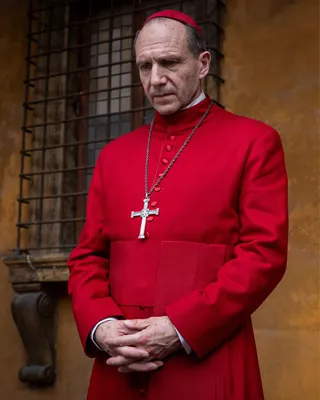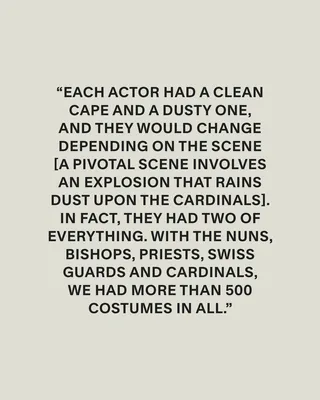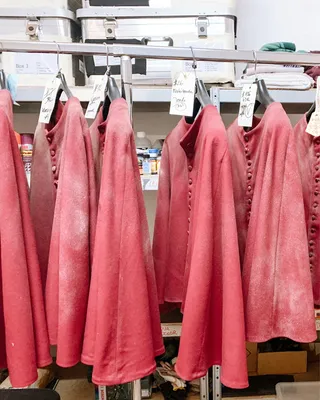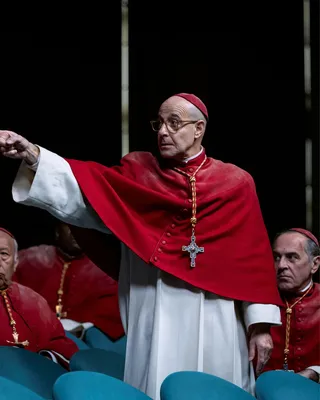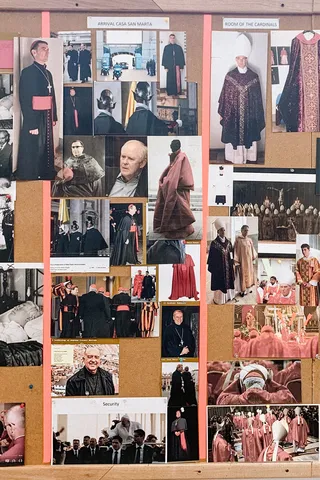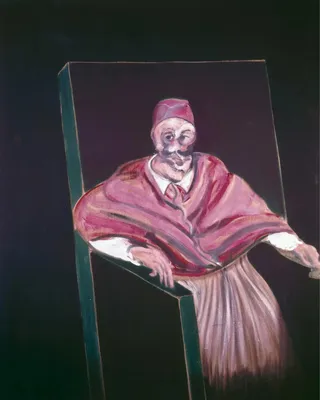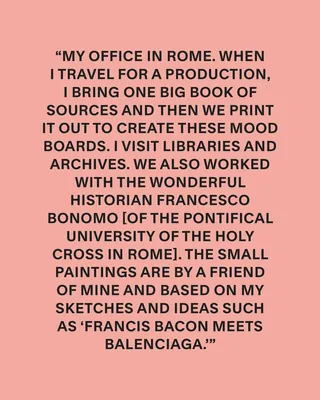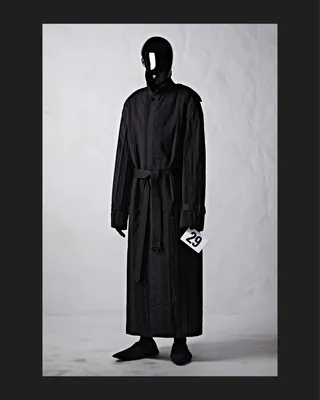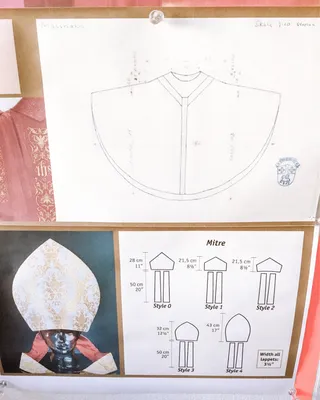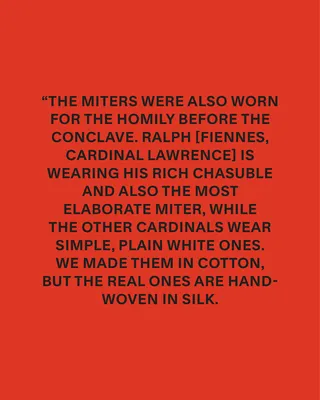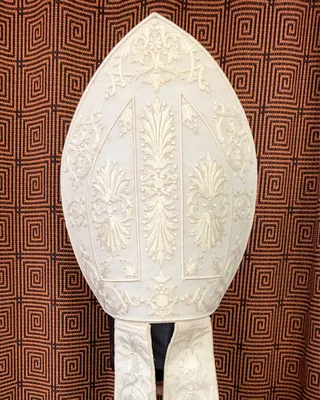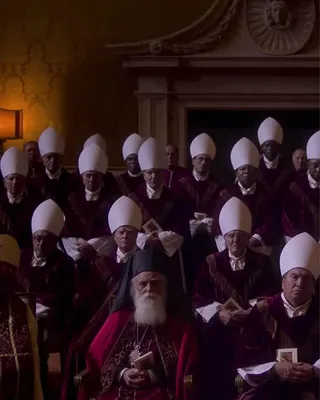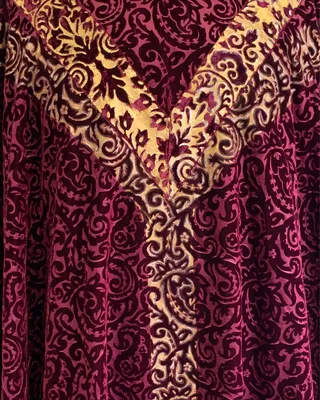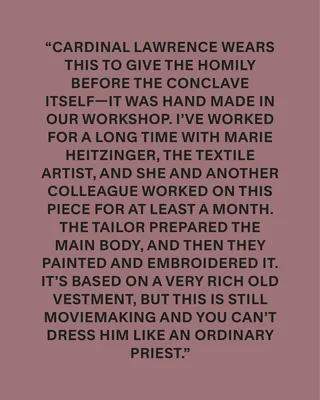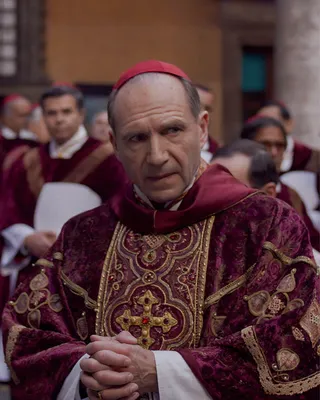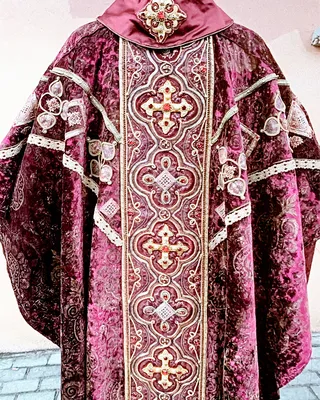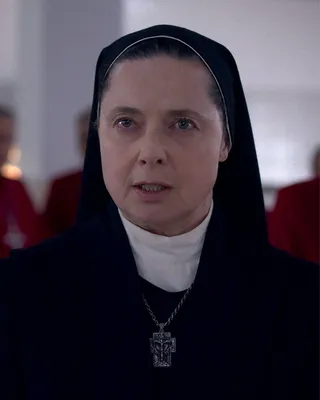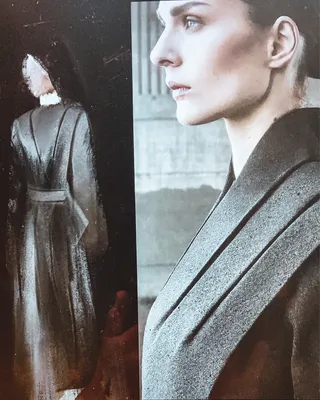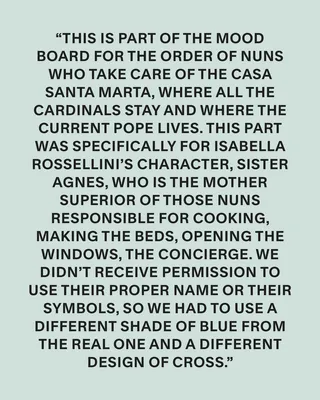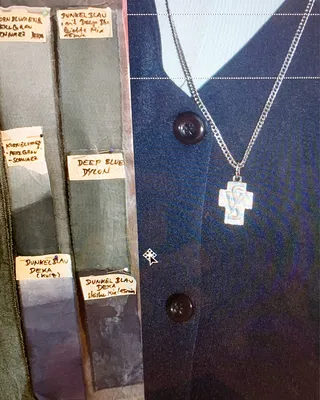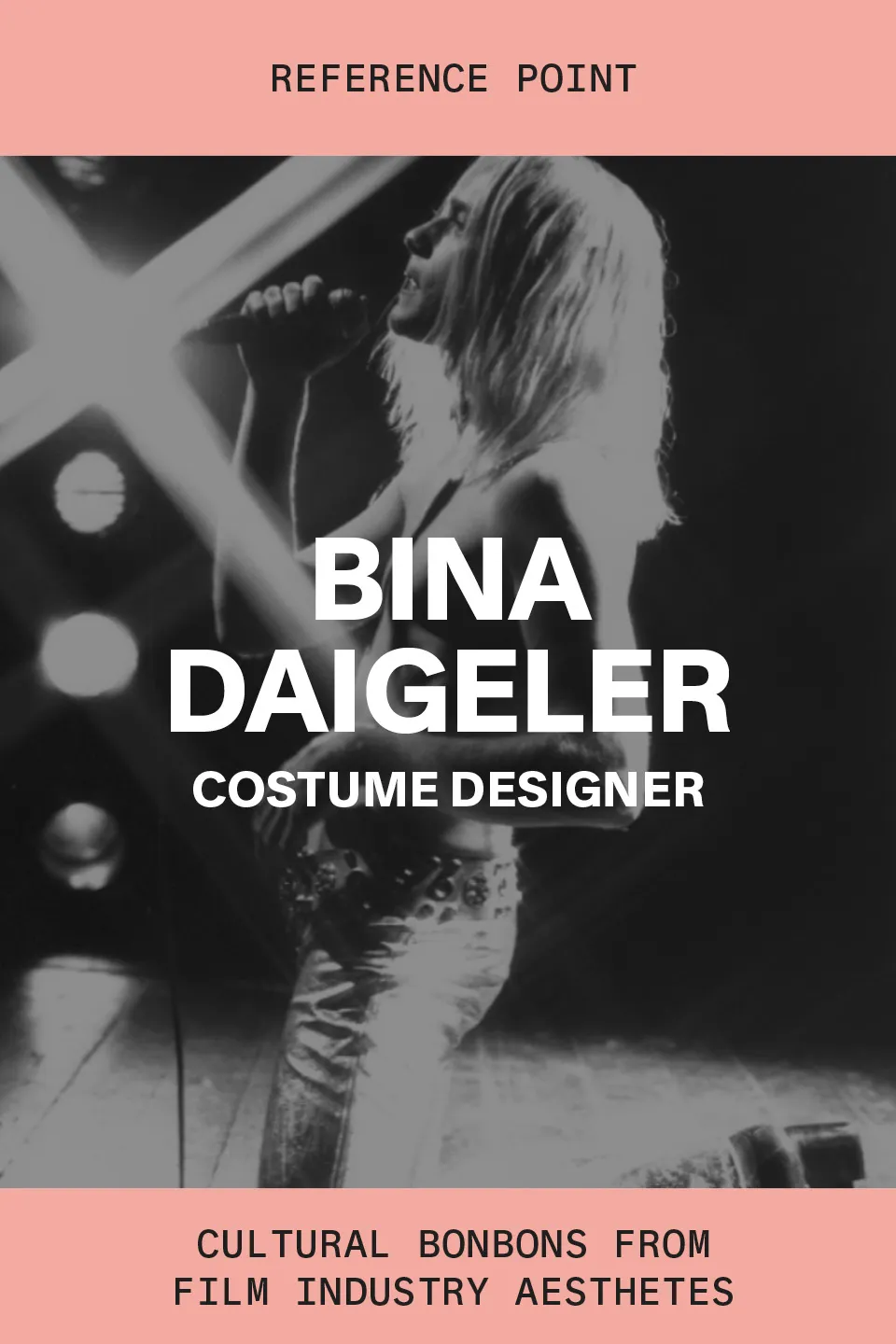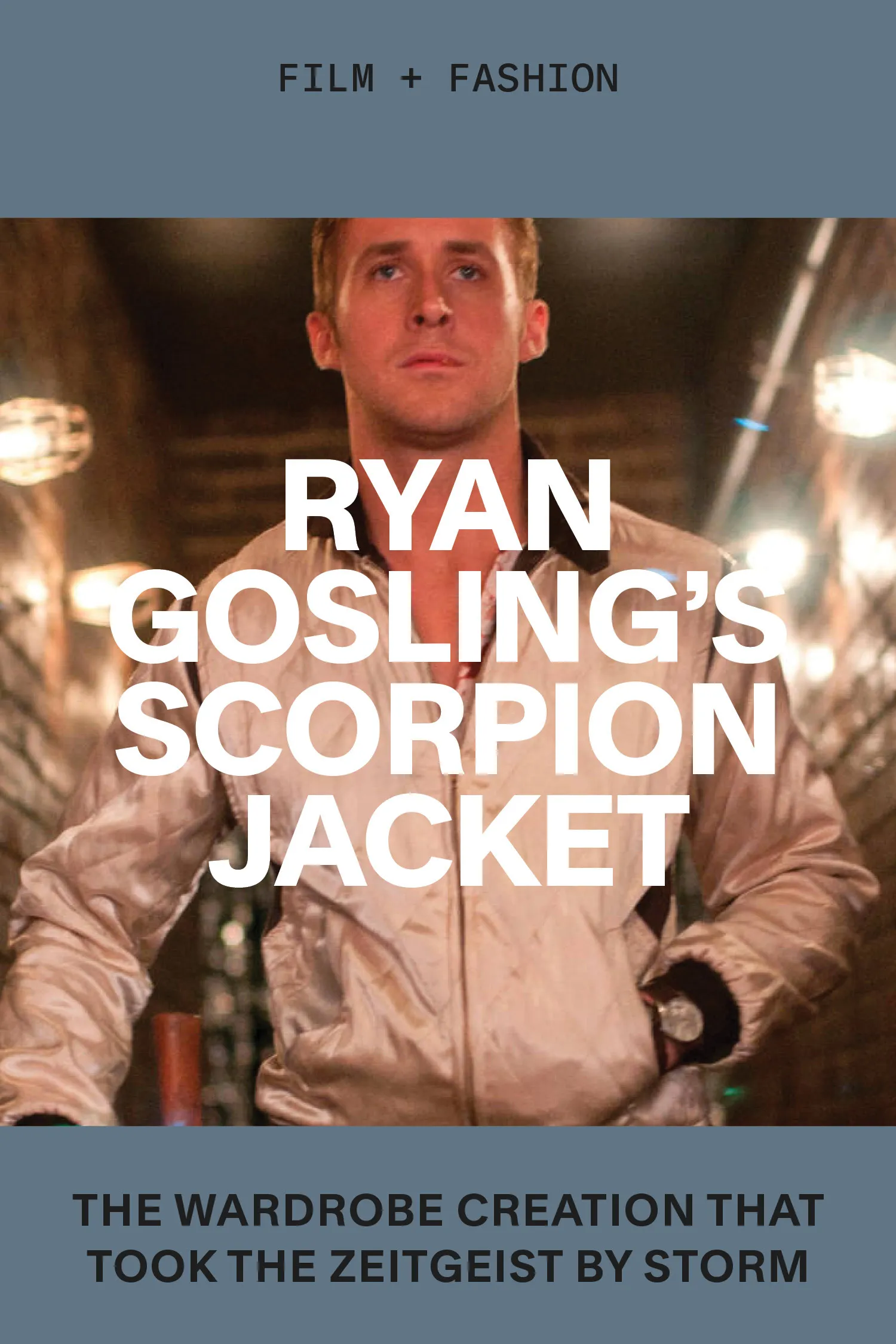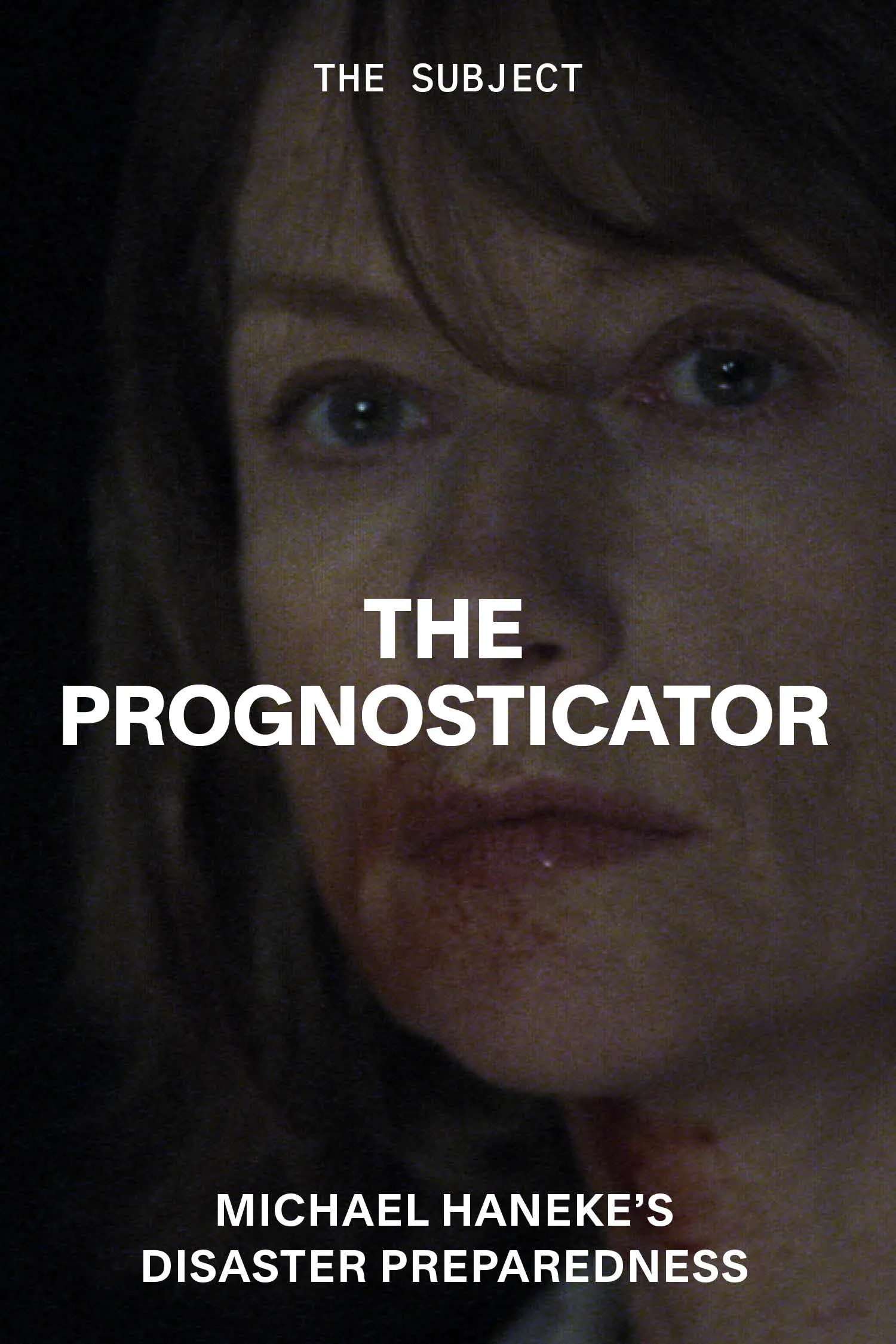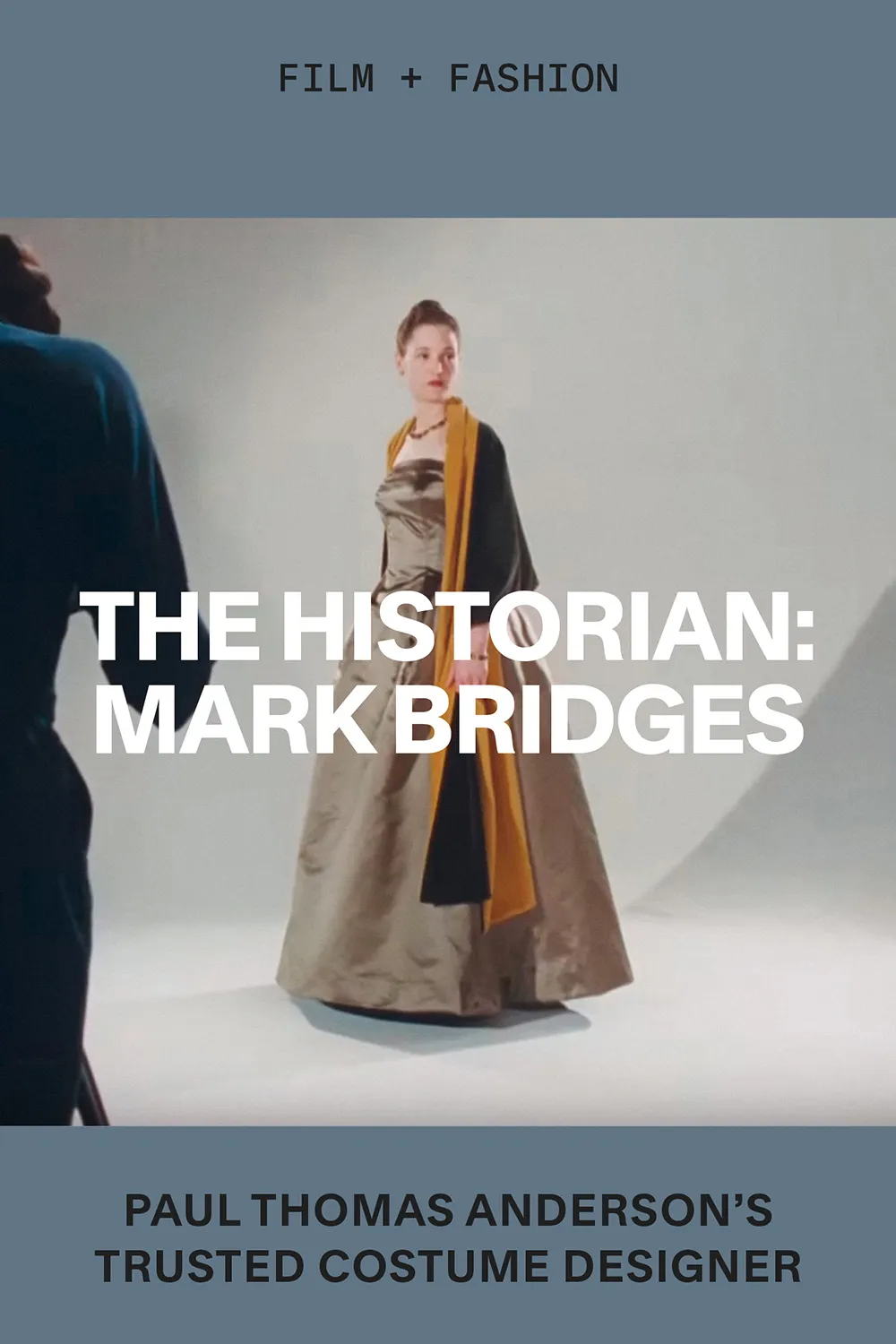Catholic Taste: Lisy Christl
By Robert Bound
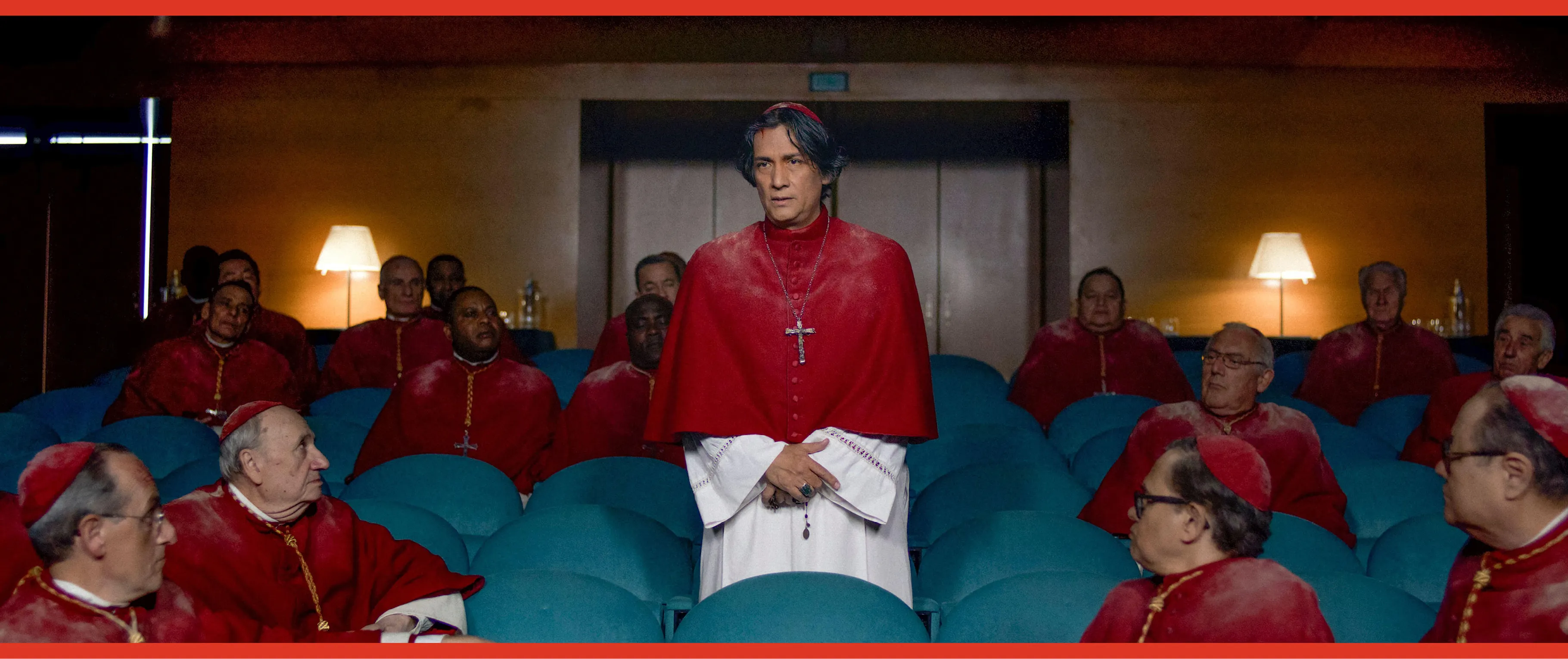
Conclave, dir. Edward Berger, 2024
Catholic Taste
Robert bound
Costume designer Lisy Christl’s structured minimalism and precise accessories vest Conclave’s cardinals with divine authority
February 7, 2025
Edward Berger’s striking clergy drama Conclave, an adaptation of Robert Harris’s 2016 novel, stars Ralph Fiennes as Cardinal Thomas Lawrence, the diffident dean of the College of Cardinals in the Vatican on whom, following the death of the pope, it falls to steer the election of a new head of the Roman Catholic Church. As the front-running cardinals—including Bellini (Stanley Tucci), Tremblay (John Lithgow), Adeyemi (Lucian Msamati) and Tedesco (Sergio Castellitto)—jockey for position to represent their diverse wings of the Church, the challenge for Cardinal Lawrence is strangely similar to that of a costume designer: When 100-plus holy men are dressed almost identically in their vermillion finery, God and the devil really are in the details.
Enter Lisy Christl. Through wonk-chic glasses, oversize crosses crafted by a Florentine goldsmith and couture-inspired clerical robes, the Bavaria-born, Berlin-based costume designer suggests the shy, the sly and the showy with subtlety and high style. Christl started as an apprentice dressmaker in a Munich couture salon before working in the costume department at the Münchner Kammerspiele and graduating from the Deutsche Meisterschule für Mode, in Munich, with a master tailor’s qualification. She worked on Michael Haneke’s films for a decade before first teaming up with Berger for his World War I drama, All Quiet on the Western Front (2022). Here she explains how to divine individuality within uniformity, by way of Balenciaga and Francis Bacon.
From left: Ralph Fiennes as Cardinal Lawrence; a rack of dusty capes (photo by Lisy Christl); Stanley Tucci as Cardinal Bellini
What’s your first port of call when you’re thinking of costumes for a project and where did you start with Conclave?
For any film, I read the script and I try to find the first images that come to me and to feel the ground spirit of a story. I worked for 10 years with Michael Haneke. It was sometimes only a landscape that you’d imagine—a dead dog somewhere, for example [in Haneke’s Funny Games (2007) intruders kill a family’s golden retriever with a golf club]. Conclave was really different because I’m very interested in this whole world of religion and clothes. Not only for Roman Catholics, but I find it fascinating to decipher some of this way of life where the rest of the world thinks they know where you live and how you live. It’s both bold and private.
You worked with Edward Berger on All Quiet on the Western Front before this. They’re very different films, but is there any sort of connection in the costumes?
When I first met Edward I said, “Look, if you ask a female designer to work on a war movie, she will ask, ‘Why on earth do you want to do this? Because it’s horrible, it’s a nightmare!’” But there is a bridge between the two movies, because they’re both uniform movies. Neither film gave me loads of space to show the man or woman behind the uniform, but I find it very interesting to try to find those small spaces.
Are those small spaces the personal details that can offer a window into a character’s personality? Did you work with the actors on these elements—their watches, glasses, hairstyles?
We all see our craft in a different way. I offer all that I can and when everything is ready, then I include an actor, because I don’t really believe in “Let’s find everything together.” I would say 99.9 percent of the actors are very happy if you present them with a concept, a scrapbook—something where you can start to think about a part. In our case, Ralph [Fiennes] comes from a religious background and he knew more. Stanley Tucci and John Lithgow, a little less. Isabella [Rossellini] was born and raised in Rome, so she just knew, and she was very happy about all my little fantasies, my little lies in her costume. Edward and I agreed immediately that we don’t really like the color of the real choir dress or the quality of the fabric of these clergy clothes, and that we are not very happy with the crosses they wear. Edward was very clear to say, “No, this is what I want.”
From left: Lisy Christl’s mood board (photo by Lisy Christl); Study for a Pope I by Francis Bacon, 1961; a look from Balenciaga’s fall 2022 couture collection
What were the main differences between the real vestments and your costumes?
A heavier fabric, for a start. And then Edward and I both saw, one week after the other, a couture show from Balenciaga in 2022. I didn’t send the images to him because I thought he might think I’m a bit mad, but then he sent it to me one week later and I told him that Cristóbal Balenciaga was a very, very Catholic man who went to church every day. So the inspiration for his clothes could have come from the church. We changed the shape of things a little bit, but it’s not too crazy: We added shoulder pads; the little cape [mozzetta] is longer; there’s no lace on the white part of the dress [rochet] and the under-dress [cassock] is slimmer. So it’s all a bit more structured, more minimalist.
Half of the film takes place in small rooms, half in vast chapels. Did you have to think of the physical presence and shape of the costumes for both spaces?
Yes, the costumes had to have a real presence in all the scenes, and I did look at 18th-century paintings of cardinals in these huge cathedrals to see how they might look in a public space, as you say. And the private space, well, I think this is not necessarily a movie all about the problems of the Catholic Church but about men who are in an election process in a very unusual environment. Edward would add that it’s a film about a man and his doubts, and also a kind of detective story. I think none of us wanted to go too deep into the religious parts, Edward was very respectful of that. The world can think whatever it wants about the Catholic Church, but I’m a costume designer and I wanted to do it all as beautifully as possible. I think the film leaves many doors open.
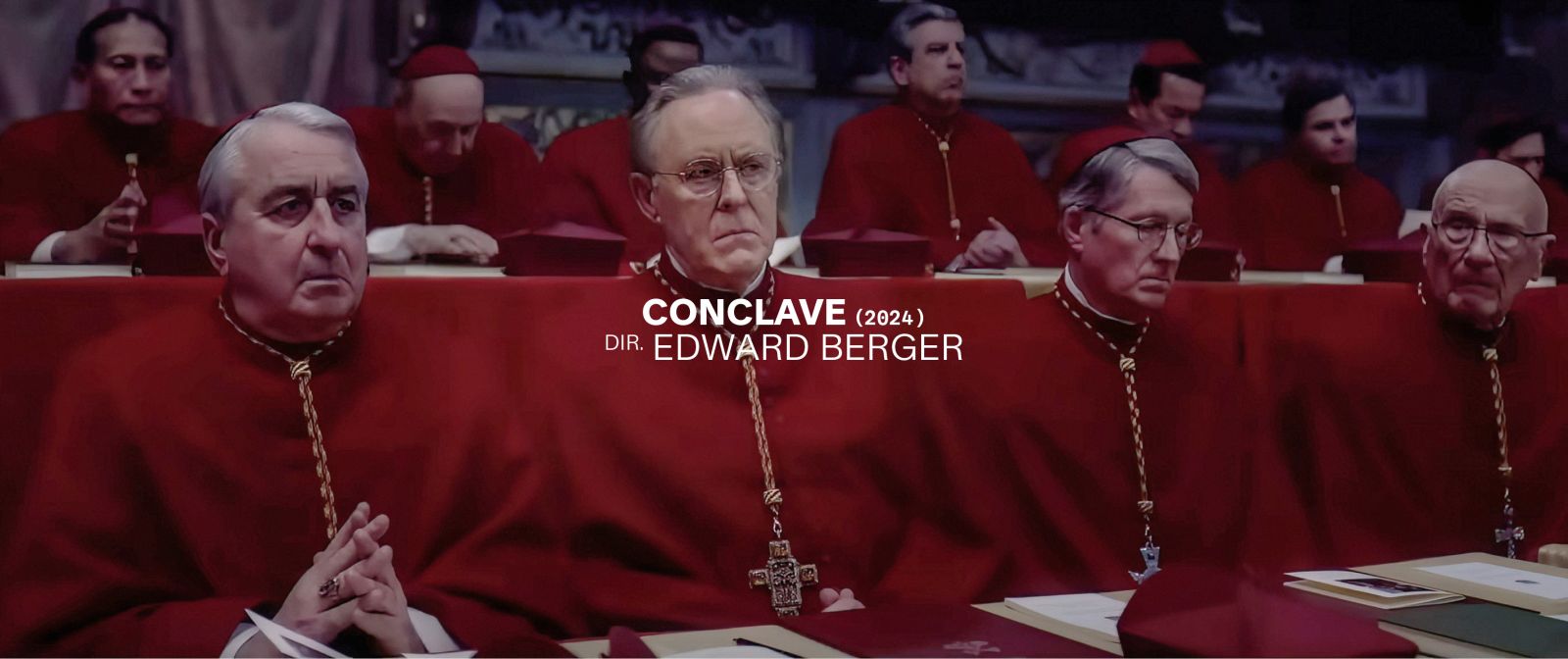
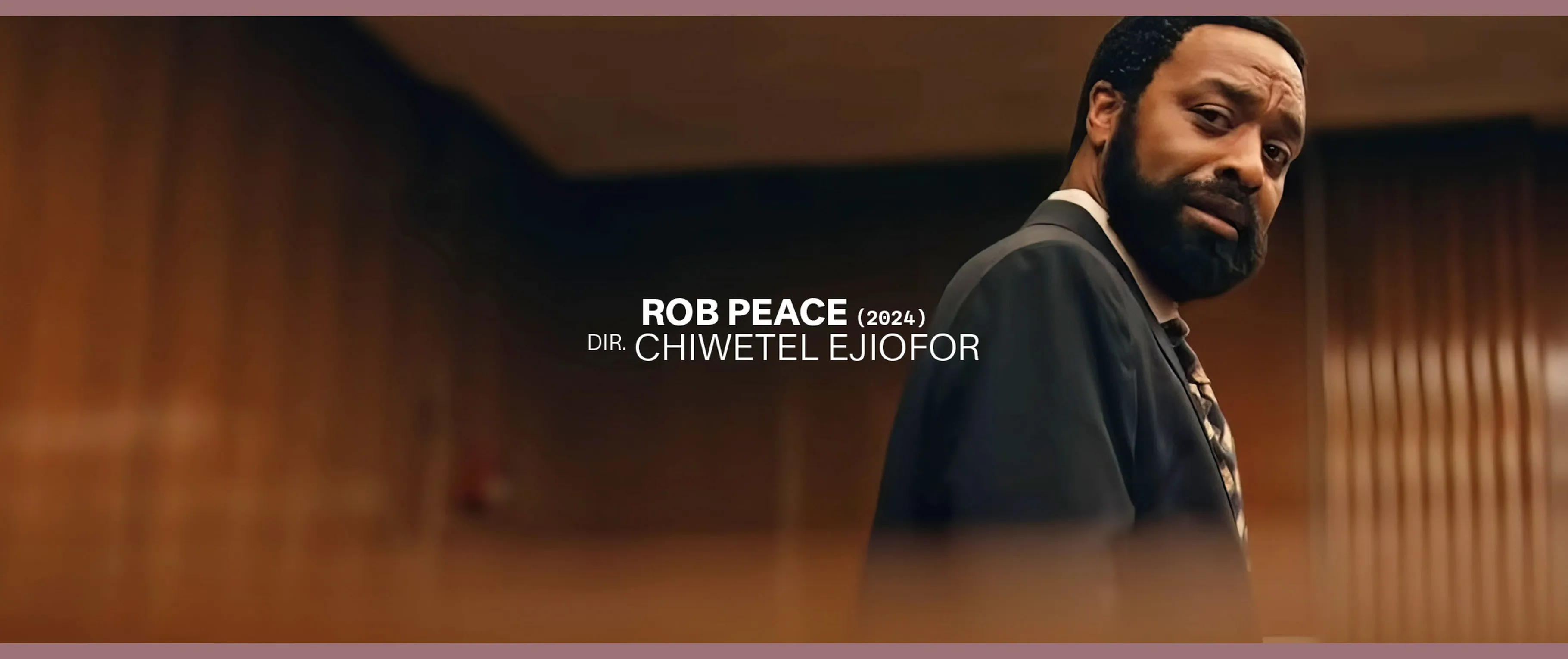
Did you attend any Catholic Church services in order to see how priests and cardinals move in their attire?
I did in Germany and it was not that pleasant, but then also in Rome, where I went almost every weekend. I visited the sacristy where they put on their garments. If you are lucky, you can find the most beautiful vestments there. I really enjoyed seeing them, and the priests are way more natural in Rome than in Germany, where they always speak a bit like they went to the wrong acting school. Italians are so easy with it, they talk to their community, and after the service they don’t have a drink literally, but it seems like they maybe all meet in the next bar and they’re part of the community. It’s the same with how they walk and talk in their vestments: so natural. I love that Stanley and Ralph and John and all the others asked if they could rehearse in their vestments, to also feel that comfortable.
There is also a sacrament, a ritual, in getting dressed in these clothes, and this is beautifully detailed and shot in the film, particularly for Ralph’s Cardinal Lawrence. You must have been very alert to the weight of the fabric and the rhythm of that ritualized enrobing process.
We rehearsed this several times with Edward and the cameraman long before we shot the real scene. I also changed the shape of some of the items for these scenes to make them more attractive for the camera—more structured, closer to the body. The two men who dress Ralph are extras, so we had to rehearse this several times. But not all of the cardinals have somebody who helps them to get dressed, and you can see some of them are pretty sloppy, and others are well-dressed. But we got it, and with the editing it’s turned out really nicely.
It really is beautiful. And the sound in those scenes is also important—there’s obviously some sound design in there but there is also the natural weight of the fabrics and the crosses, the snap of leather and the echo of the marble floors. Was this also a factor for you?
I’m very much into sound, so yes. As I said, I did my first 10 years with Michael Haneke, so you have to think of everything and you’d better be prepared. Marble and hard leather are a nightmare for sound, so you have to have black leather shoes with very soft soles. The only one for whom we made shoes by the shoemakers of the pope was Cardinal Tedesco [played by Castellitto]. He has the real deal.
From left: costume sketches and a cardinal’s miter (photos by Lisy Christl); miters on display in Conclave
Was that to suit the requirements of the character or the actor? Or were they slightly one and the same?
In a way. Tedesco is the cardinal of Venice, and he seems to have this special status within the church. I believe there is a red cape that he and the pope can wear but no one else. Sergio Castellitto is a superstar in Italy, and yes, I wanted to show him my respect, that I know that he is in Italy what Ralph is in England. Ralph’s role is as a humble man. Tedesco wants to go back in time to another century, to the glory of the Catholic Church. His attitude is: Let’s go back and speak Latin, let’s go back in the past, let’s not look at the community. Look at the cross. This is how we celebrate Jesus. Right? You have to get ready for all of the actors with the right materials because they are supersmart. So you’d better be prepared. And Sergio was the perfect guy for me.
Well, he looks very handsome in his vestments, doesn’t he?
Oh yes, and when he came he was a bit grumpy and he thought, “I know: It’s going to be another cassock from any old costume house.” But he was in heaven when he saw his shoes with his initials in black and gold! All his costumes were on mannequins, and he walked in and his face changed. I love this! It sets up the mood for the whole shoot.
So there’s a professional and a pastoral element to your profession as a costume designer?
Yeah, always give an extra inch. In the script it’s written, “Tedesco arrives, and he behaves like a butcher.” And I wondered how this elegant man could behave like a butcher. But you remember when he arrives and hugs Lawrence and then slaps the porter away as the young man is trying to help with his luggage? None of us could really believe what we saw. It was really a masterpiece, that small interaction.
A hugely diverse array of artists, from Raphael to Francis Bacon via Van Eyck, has painted popes and cardinals, either by commission or intended as critique—were these also on your mood board?
Oh yes, and I was recently in London and went to the Bacon exhibition at the National Portrait Gallery and saw them for the first time—so big, so wonderful. Then again, there is barely a palazzo in Rome where you don’t see a painting of a cardinal or a pope. On a mood board you collect all sorts of things: details from a book just about paintings of cardinals; the kind of red that the cardinals in the 16th century wore; all of this. Many of the cardinals were rich, they gave bread to the painters—they were patrons. Maybe you can tell how much bread they gave by how much slimmer or taller they are in the paintings than they may have been in real life.
From left: detail of chasuble (photo by Lisy Christl); Ralph Fiennes as Cardinal Lawrence in Conclave; Cardinal Lawrence’s chasuble (photo by Lisy Christl)
Naturally. And as for your own diverse range of projects: a decade with Haneke, then with Edward Berger for All Quiet on the Western Front. Before that you worked on the Shakespeare story Anonymous [2011], which is full of Elizabethan costumes with all the doublets and hose. What was that mood board like?
Well first, that film starred Vanessa Redgrave—the goddess. This makes you pretty nervous, you lose many pounds when you meet her the first time. I absolutely loved working on Anonymous. This is my kind of era—15th, 16th, 17th centuries—I’m so at home there. And it was so wonderful to get the courage not to copy Sandy Powell, what she did for Shakespeare in Love, (1998) or what Alexandra Byrne did for Elizabeth (1998). Because these films were already out there, I had quite a knot in my brain. What can you do? Nothing but find your own way, and it took me quite a while, and I think I’m still fine with the result. I didn’t watch it for a long time, but I think it still works.
Could there be a similarity between the Elizabethan court and the cardinals in Conclave: an idea of living in public? Everyone is on show and everyone knows it, and so there is a kind of uniform, but everyone is accentuating their best bits. This is a gift for a shy person in real life and especially a gift for an actor. I think your costume designs allow that—is there any sense in that?
I like the sound of that, but I also think you always have to wonder, in whatever period you work, what would be the comparison today for a nobleman in the 16th century? Is it maybe a Breitling watch or a big car? They were all trapped in this Elizabethan court and the only show-off possible was jewelry and clothes. Somebody who lives in a certain environment for a while knows how to present himself or herself at their best. Perhaps today there is too much choice of what to wear and people are overwhelmed, but 50 years ago, you could clearly see: Sunday, Monday, work, rest. You know? This has changed, and we have found new codes today. But clothes have always been a language.
From left: Isabella Rossellini in Conclave; images from Lisy Christl’s mood board (photos by Lisy Christl)
